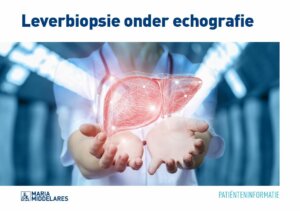Liver biopsy
What is it?
What is it?Under a local anaesthetic, a fine needle is used to remove a liver tissue sample for microscopic examination. This is a safe procedure that is usually performed without any problems.
When?
When?After thorough study of your symptoms, clinical tests, extensive laboratory tests and additional information from examinations such as echography and scans (CT or MR), a liver biopsy may be offered. Generally, the procedure is necessary to achieve a precise diagnosis of a liver disorder because this information cannot be obtained with certainty in any other way.
If your physician recommends a liver biopsy and you decline, this may result in a delayed or mistaken diagnosis, with possible unpleasant consequences and suboptimal therapy options.
Things to consider
Things to considerDo not hesitate to ask for further explanation should you have any doubts or queries! Inform us if:
- Pregnancy
- Allergy, sensitivity or intolerance (e.g. latex, Lidocaine)
- Clotting problems or use of blood thinners (e.g. Marevan, Sintrom, Marcoumar, Ticlid, Plavix, Pradaxa, Xarelto, Aspirin, etc.)
- Artificial valve or prosthetic: some patients require antibiotics before and after the procedure
- Epilepsy, diabetes, chronic heart, lung and kidney disorders: special attention to medication required
Course of the procedure
Course of the procedurePreparation
- You will be admitted to the day hospital for the procedure. Check in at one of the e-kiosks with your identity card. Follow further instructions on the ticket.
- Please arrive fasting (for a minimum six hours). Liver biopsies are generally performed in the morning.
- Leave removable dentures in your room. Damage to teeth (higher risk if teeth are in a poor condition) cannot be ruled out during an endoscopy or anaesthesia.
Procedure
- The optimal biopsy site in the liver is selected by means of ultrasound. If necessary, the trajectory of the needle can be monitored on the ultrasound screen during the procedure.
- After disinfection of the skin, the skin and the needle trajectory are numbed. A small incision is made into the skin. A tissue fragment is collected with a biopsy gun. This happens very fast.
After the procedure
- You will remain in bed after the procedure. You may only get up to go to the toilet. If you have not developed any pain by the afternoon, you may eat a light meal.
- If the physician agrees, you may go home in the late afternoon. Please do not drive home yourself.
- Avoid any activities the following day that may result in trauma, such as a fall or impact.
Safety and hygiene
Safety and hygieneWe are an experienced and well-trained team, equipped with a modern infrastructure.
Possible complications
Possible complicationsAfter the procedure, you may experience nausea, stiffness or light shoulder pain for a short period of time. This will disappear by itself.
A very rare complication is bleeding or perforation of a nearby organ. This sometimes results in urgent surgical intervention.
Another very rare complication is a puncture of the lung membrane (pneumothorax). This may result in a minor surgical intervention.
Contact us if you have the following symptoms after the procedure:
- persistent severe pain
- fever
- blood loss (red or black stools)
- any concerning symptom
Downloads
DownloadsOnly available in Dutch:

Leverbiopsie onder echografie
DownloadCost estimate
Cost estimateCentres and specialist areas
Centres and specialist areas
Latest publication date: 16/05/2024
Supervising author: Dr Monsaert Els



